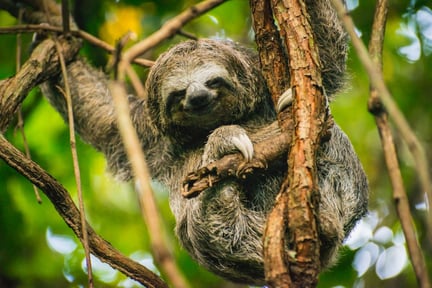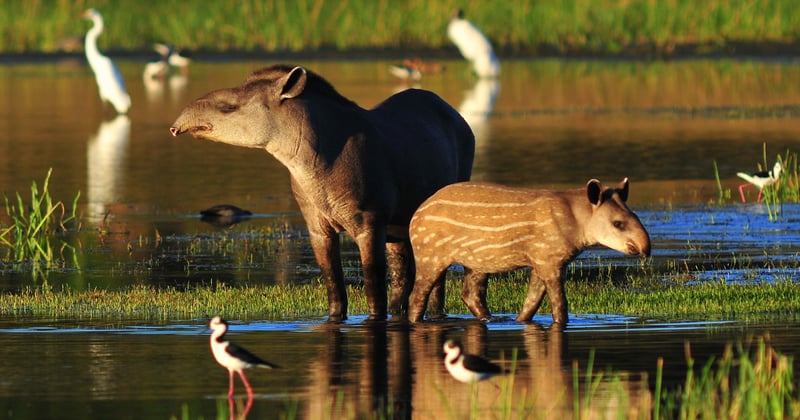
15 fascinating tapir facts
Blog
With their distinctive snouts and sturdy bodies, tapirs look like a mix between an anteater and a pig. Take a look at the tapir facts below to learn more about these quiet animals and discover the big impact they have on their habitats.
While also found in Southeast Asia, tapirs are the largest land mammals in South America. But what do these animals eat, how do they communicate, and what threats do they face?
Here we provide a ton of interesting tapir information. We also take a look at tapir conservation, exploring what you can do to support the survival of endangered tapirs around the world.
Learn more about South America’s largest land mammal
1. There are five species of tapir
The four most well-known species of tapir include the mountain tapir, Baird’s tapir, the lowland tapir, and the Malayan tapir.
However, a new species of tapir, Tapirus kabomani, was recently “discovered”. Also known as the little black tapir or the kabomani tapir, this species was known to locals for years but was only recognised by scientists in 2013. Like the lowland tapir, this new species of tapir is found in the Amazon Rainforest.
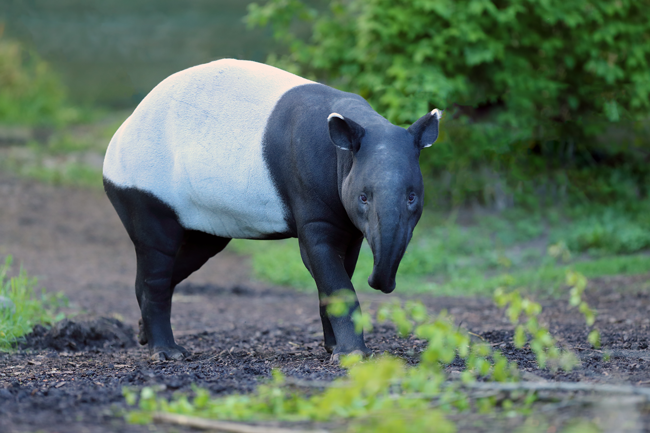
2. The Malayan tapir is the largest
Here’s a fun tapir fact for you: the world’s largest tapir is the Malayan tapir, which can grow up to 3 metres long and weigh up to 400 kilograms. This species has a black head, shoulders and legs, and a white rump, back, and belly.
The smallest tapir is the mountain tapir, which is also known as the Andean tapir or the woolly tapir. This species has a black or dark brown pelt, a thick woolly coat, and white lips. Adults usually measure around 1.8 metres in length and weigh up to 200 kilograms.
Other tapir species fall somewhere in between these sizes. They tend to have short coats that range in colour from reddish brown to grey to dark brown.
3. Tapirs have long snouts like anteaters — but they aren't related
Tapirs and anteaters both have long snouts and are roughly the same size. They also live in the same part of the world. But is a tapir an anteater? Nope!
Tapirs have a short trunk, which they use to pull leaves and fruit from branches. Unlike anteaters, they don’t eat ants or any other kinds of insects.
4. Tapirs are great swimmers
Tapirs don’t look like the most aquatic creatures, but can tapirs swim? They can — and are — much more graceful in the water than you might imagine.
In fact, tapirs are excellent swimmers. They dive down to reach aquatic plants and sometimes walk along the bottom of the riverbed, feeding on vegetation. They also submerge themselves underwater to hide from predators, using their trunk as a snorkel.
Tapirs spend time in water to cool down and wallow in mud to remove ticks from their skin and protect themselves from insect bites.
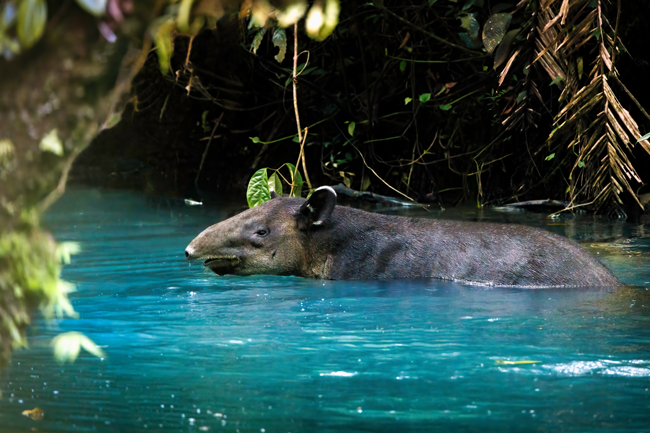
5. Tapirs are related to rhinos and horses — but not hippos
We already tackled the misconception that tapirs and anteaters are the same. In fact, the two species are not even closely related. Nor are tapirs related to hippos.
Surprisingly, tapirs have much more in common with rhinos and horses. They are all hoofed mammals with an odd number of toes, known as perissodactyls or odd-toed ungulates. They also have similar digestive systems. It’s thought that the common ancestor of tapirs, rhinos, and horses lived in India millions of years ago. Now that’s what you call a fun tapir fact!
6. Tapirs live in Central America, South America, and Southeast Asia
Where do tapirs live? Different species of tapir live across South America and Southeast Asia in tropical and sub-tropical forests and shrublands, as well as in wetlands, like bogs and swamps.
The lowland tapir (also called the South American tapir, the Brazilian tapir, the Amazonian tapir, and the maned tapir) is found in the lowland areas of northern and central South America, including Argentina, Bolivia, Brazil, Colombia, and Ecuador.
The mountain tapir is found in the Andes Mountains in Colombia, northern Peru, and Ecuador. It used to live in Venezuela too, but is now extinct there. This tapir lives at elevations ranging from 1,400 metres up to the snow line.
Baird’s tapir lives primarily in Central America, in forest, shrubland, and wetland areas in Belize, Costa Rica, Guatemala, Honduras, Nicaragua, and Panama. It can also be found in southern Mexico and northern Colombia.
The Malayan tapir is found in the forests and swamps of Malaysia, Sumatra, southern Thailand, and southern Myanmar.
7. Tapir habitat in Brazil is being destroyed by devastating fires
In parts of Brazil, land is being cleared and set on fire at record levels. The aim? To grow crops to feed farmed animals.
However, fire poses a serious danger to the wildlife living in these habitats, including tapirs. Yep, not all tapir facts are fun!
These fires destroy food sources, shelter, and breeding grounds. They are also responsible for the injury and death of resident wildlife. In 2020, conservationists estimated that over 17 million animals died as a result of these fires, with many millions more injured or displaced from their homes.
Take Melancia. She’s a young tapir who was found without her mother following forest fires. She had severe burns on her paws, which exposed her bones and severely limited her movements. Valente had similar injuries and — along with Melancia — is receiving treatment for his burns at the Onçafari, a rehabilitation centre supported by World Animal Protection.
Eventually, these tapirs will be released back into the wild. But without support from organisations like Onçafari and a change to farming regulations, the survival of tapirs like Melancia and Valente is in doubt.
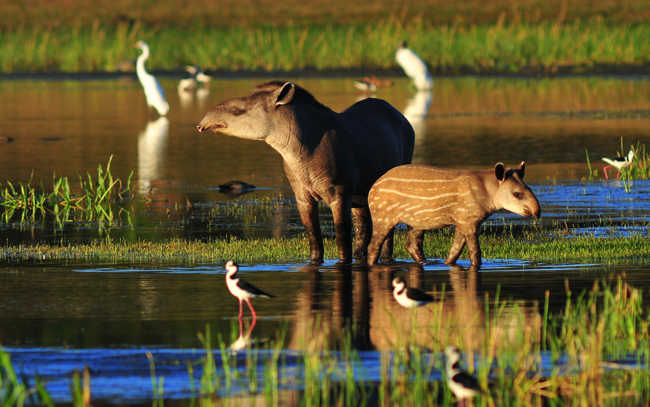
8. Tapirs are known as “danta” in Colombia
Tapirs and “danta” are the same animal. “Danta” is the name given to tapirs in Colombia, where they are also known as “gardeners of the forest”.
Baird’s tapir has lots of different names. It is known as the mountain cow in Belize and as the jungle horse in parts of Mexico. Bush cow and forest cow are other nicknames.
9. Tapirs are highly intelligent, sentient beings
Tapir behaviour proves that these mammals are highly intelligent and sentient, with their own thoughts, feelings, and personalities.
Tapirs can communicate with each other in a variety of ways. They make noises, including a snort (which is usually accompanied by a foot stamp), to indicate that the tapir is about to defend itself. Other noises include a shrill squeal when the tapir is scared or in pain and a lower-frequency squeal when exploring.
Tapirs also communicate through urine marking. They mark paths through the forest, sniffing and identifying other tapirs to avoid confrontation and conflict.
10. Tapirs eat a herbivorous diet
So what do tapirs eat? These herbivorous animals mainly munch on leaves, shrubs, and grasses. But the tapir diet consists of seasonal fruit and berries, too.
Tapirs are largely nocturnal. However, the mountain tapir is more active during the day than other tapirs. All tapirs spend most of their waking hours foraging for food, travelling along familiar routes. An adult tapir can eat as much as 34 kilograms of food in a single day.
One of our favourite cheeky tapir facts? Tapirs are often found underneath mango and fig trees when fruit is ripe, waiting to catch the fruit dropped by monkeys eating in the branches above. Now that is clever behaviour!
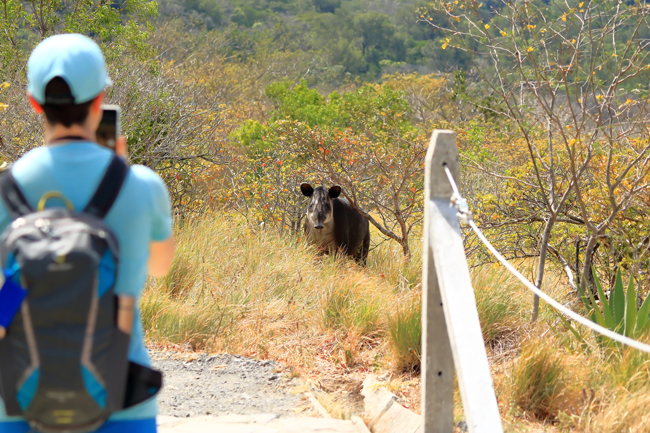
11. Tapirs are essential to the ecosystem as seed dispersers
Tapirs are the largest native land mammal in South America. They’ve earned their nickname, the “gardeners of the forest”, because of the important role they play as seed dispersers.
Scientists believe tapirs might be the last potential seed disperser of plant species previously dispersed by other, now extinct, large mammal species.
They support the diversity of plant species by consuming a wide range of different seeds and then dispersing them, in their dung, across long distances. By dispersing seeds across disturbed forests, tapirs may also contribute to natural forest regeneration.
12. Factory farming and soy production threaten tapir survival
Cruel factory farms rely on lots of crops to feed livestock. Soy is a popular choice for farm animal food, and Brazil is one of the biggest producers of soy in the world.
As demand for meat increases, more land is cleared to make way for soy crops. Sometimes, land is cleared quickly by the deliberate setting of fires. This includes land in some of the world’s most iconic and vulnerable places, including the Cerrado and the Pantanal, where many tapirs live.
After the land has been cleared, farmers tend to grow crops in large monocultures. This leads to a loss of biodiversity and soil fertility. Monoculture crops are also more susceptible to disease and pests, which means vast amounts of pesticides and fertilisers are needed.
Habitat destruction, poisonous pesticides and fertilisers, and the risk posed by fires are all threatening the survival of tapirs and other Brazilian wildlife. We need to promote sustainable land use and agricultural practices to prevent more tapir habitat from being destroyed. We can also do our bit at home by reducing meat consumption.
13. Tapirs choose flight over fight
Tapirs aren’t usually aggressive or dangerous creatures, and usually choose to hide from predators, which include large cats and crocodiles.
To stay safe, tapirs sometimes hide underwater, poking their snout above the surface to breathe. They also have thick skin on the backs of their necks that protects them from predator bites. Baby tapirs can self-camouflage too; for the first months of their lives, tapir calves have stripes and spots that help them blend into their forest habitat.
Tapirs will usually choose flight over fight. However, they sometimes try to deter predators by snapping and biting.
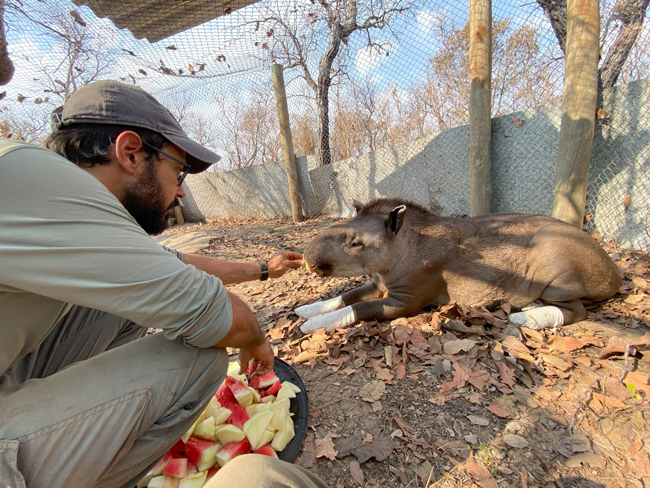

Donate now
When you make a donation, you’ll join a passionate group of supporters who are determined to change the world for animals. We're fighting animal cruelty wherever we find it — are you with us?
Donate14. Tapirs are used in traditional medicine
Another sad tapir fact: tapir body parts are used in traditional medicine.
In Peru, at the Belén market, the largest open-air market selling wildlife in the Peruvian Amazon, live mammals, reptiles and birds — and their body parts — are sold. Some are sold into the exotic pet trade, some for for spiritual, medicinal, and decorative use, and others are killed for their meat.
At this market, tapir nails are sold as a purported treatment for haemorrhages, despite a lack of scientific evidence to prove their effectiveness.
15. There are fewer than 2,500 mountain and Malayan tapirs left
So which tapir species is the most endangered? According to the IUCN Red List, the lowland tapir is vulnerable with a decreasing population. Endangered tapirs include the mountain tapir, Baird’s tapir, and the Malayan tapir.
There are an estimated 2,500 mountain tapirs left in the wild and an estimated 2,499 Malayan tapirs. Numbers of Baird’s tapirs are a little more uncertain.
But researchers estimate that there may be 500 to 600 in the Mosquitia area of Honduras and Nicaragua, 600 to 800 in Costa Rica and Panama, and around 1,000 to 15,000 in the Maya Forest of Mexico, Belize, and Guatemala.
Tapir threats include loss of habitat through deforestation, the conversion of habitat into farmland, collisions with vehicles, hunting for meat, and competition with domestic livestock. These threats are particularly severe because female tapirs only give birth to one calf every two years so it’s very difficult for tapir numbers to recover.
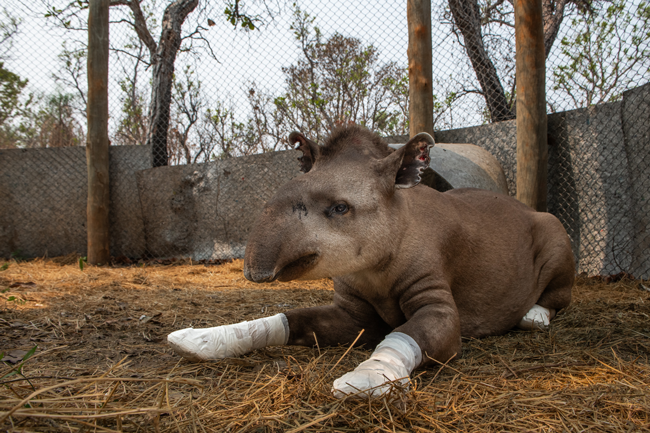
Save the tapir: how to protect tapirs
As we’ve seen from the tapir facts above, tapirs are vital to their ecosystems. Yet they face immense threats. Here’s what you can do to help save the tapir:
Raise awareness about tapirs and the role they play in their habitats
Advocate for sustainable farming to reduce deforestation and protect tapir habitats
Support tapir conservation organisations, like World Animal Protection, who are working to protect tapirs around the world
With our help, we’re hopeful that tapir numbers can recover and that tapirs in both South America and Southeast Asia can once again thrive.
An easy action you can take today? Join our global community of animal protectors. Sign up to the World Animal Protection newsletter to hear about our latest campaigns.
